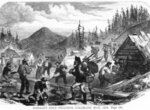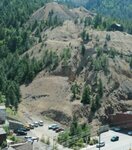

John H. Gregory was an experienced miner who had learned how to prospect for gold in 1827 in Georgia. He had lost all his money in the Panic of 1857. So, in 1858 he left his wife and kids in Georgia for the Fraser River gold fields in British Columbia. Gregory ran out of money in Lawrence, Kansas so he took a job driving a mule train to Fort Laramie in Wyoming. While there during the winter of 1858, he heard of the gold discoveries in the foothills of the Snowy Range by W. Green Russell and his brothers. He decided to set out during the dry winter days of early 1859 to prospect all the streams emanating from the base of the mountains southwards from Fort Laramie.
For the next four months he panned every stream gully that drained the Front Range, working his way south toward what would become Denver. He had little luck until he reached what was then called the Vasquez Fork of the South Platte River, (now Clear Creek).
By himself, he followed the gold showings up branches of the river deep into the uncharted wilderness of the mountains until he found what he felt was the source of the gold in the creek. Before he could prospect the area further, a spring snow storm forced him to seek shelter on the lee side of a big boulder next to two small spruce trees. He hollowed out a spot under the trees with his gold pan and hunkered down to wait out the spring snow storm under his bear skin coat.
Two days later, Gregory emerged from his burrow to waist deep snow. The thick deep spring snow had covered everything on the ground and obscured all of the local landmarks, making it impossible for him to stake a mining claim, or know exactly where he was.
He was cold and had eaten the last of his deer meat waiting out the storm, so he was forced to leave his discovery and fight his way through the snow, rocks, and fallen timber back to town for supplies. He was too tired and weak to even shoot a rabbit for food along the way. After a few days he finally reached a row of cabins at the base of the mountains that was called Arapahoe (near the present site of Golden).
Although he had no money, he drifted into the local saloon hoping to find someone who would buy him a drink. The improvised bar at the saloon in Arapahoe consisted of a wooden plank laid across a couple of crates with two tin cups to share shots of Taos Lighting. In the saloon, he met a clean-cut man with a large walrus mustache named David K. Wall who gave him a dollar so he could buy some food. Wall was a farmer who had staked out a homestead east of town. After eating, Gregory walked to the two-doored cabin down the street that served as a hotel. The dollar he was given was only enough to buy a meal, so the owner of the hotel let Gregory sleep on the floor under his bearskin robe for free.
After a few days of recuperation, Gregory set out to Wall’s farm to try and convince him to provide Gregory with some supplies in exchange for a portion of what he discovered; typically referred to as a “grubstake” agreement. David K. Wall was more interested in buying a cow for his farm, but he trusted Gregory and agreed to grubstake his endeavor if he brought along his greenhorn friends from Indiana, who “don’t know gold from beans-except they would probably try to fry both of them in a pan.” The greenhorns included Wilkinson (Wilks), and Archibald (Arch) Defrees, John and Charles Zeigler, William Fouts (from Missouri) and three others.
The night before they started out, the Ziegler brothers (who had the most money) took everyone out to the saloon in Arapahoe for drinks. One drink led to another and before they knew it Charles Ziegler had revealed the scheme to “Dr.” D. Joseph Casto, W. H. Bates and five others from Iowa, who were equipped with a mule and two-wheeled wagon. Dr. Casto (a former Baptist divinity student) and his group could not get their supplies assembled by the next morning, so Gregory drew them a crude map and they all agreed to meet at the site later. They shook hands and toasted the agreement by sharing two tin cups of Taos Lightning.
Around noon the next day, May 6, 1859, Gregory and his rag-tag party of greenhorns that included Wilkinson (Wilks), and Archibald (Arch) Defrees, John and Charles Zeigler, William Fouts (from Missouri) and three others arrived at the bottom of the wooded gully where he had weathered the snow storm earlier. Gregory and Wilks Defrees scrambled through patches of snow, aspen leaves, and pine needles for about 200 feet up the south side of the gulch. The ground was still frozen, but hey managed to scrape up enough dirt from a rock outcropping that looked “jest like the burnt quartz of the Georgia mines I worked in” and the two returned to the creek to pan the dirt with the others. They were soon able to pan four dollars in gold (about 0.2 ounces) out of that first pan of decomposed quartz vein material. This little group had discovered the first lode gold (the Cornish term for vein gold) found in the Territory. They called it the Gregory Lode.
There were no mining claim laws in this wilderness, so Gregory and the group felt that it would be fairest if every man could claim a piece of the vein. As was typical in the California gold fields, Gregory decided that each man should own part of the vein, so it was determined that a claim of fifty feet wide and one hundred feet along the ledge, or vein, was a fair allotment, with an extra claim allowed to the discoverer.
The next day the group washed out 40 pans of dirt and recovered 2 ounces of gold (worth about $40). Gregory scouted out both sides of the gully and determined that the gold “ledge” or vein, extended from the southwest to the northeast while the others cut down some aspen trees to fashion stakes. Starting in the creek, they paced out the first lode mining claims staked in the territory. Following the vein to the southwest, from the creek, Wilkes DeFrees staked claim No. 4, Gregory staked his original discovery claim No. 5 and his extra discoverer allotment claim, No. 6.
The ground was still frozen, so for the next three days the men commenced to building sluice boxes and improving their crude sleeping quarters. That evening who should come struggling up the timber filled gully, but Dr. Casto, Colonel Bates, a mule, a cart, and the five others from Iowa they had met at the Saloon in Arapahoe (Golden).
That night, the fifteen men called a Miners Meeting and Dr. Casto wrote down; “The Laws and Regulations of The Miners of Gregory Diggings District.” The document adopted Gregory’s original mining claim boundaries and clarified the rules of the newly formed Mining District, “For the settlement of differences and for the purpose of preventing disputes.” Each miner was entitled to one mountain (lode) claim and one gulch (placer) claim, except by purchase or discovery, and the miner was required to work their claims within ten days from discovery so as to avoid non-resident speculators. As it turned out, these small mining claims caused more disputes than they settled when the veins had to be mined by expensive underground mining methods.
Colonel Bates offered to pay Gregory $200 a day to find another lead and once the ground thawed out, he discovered the Bates Vein on May 16th, about 750 feet up the gully followed by the Gregory Second vein, adjacent to the Gregory vein. J. Hunter and W. T. Kendall soon discovered the Hunter Vein (the southwestern extension of the Bates Vein), and by May 20th, Dr. Casto had discovered the Casto Vein on Casto Hill northeast of the Bates vein. On May 24th Gregory and W. N. Byers discovered the Mammoth Vein. On May 25th Wilkes Defrees and Henry (Harry) Gunnell discovered the Gunnell Vein.
By the first of June, over four hundred men had poured into the gulch when William Green Russell and another one hundred and seventy followers arrived. All the most productive veins in the district had already been discovered, but W.G. Russell was an experienced miner and he soon found rich placer deposits in Russell Gulch, about a mile south of the Gregory Diggings.
During the summer over 30,000 people streamed into Mountain City at the Gregory discovery site and what would later become Central City and Black Hawk.
[References:
Fossett, F., 1876, Colorado, Its Gold and Silver Mines, Farms and Stock Ranges and Health and Pleasure Resorts: 1st ed., Crawford, N.Y.
Hollister, O.J., 1867, The Mines of Colorado, Samuel Bowles and Co., Springfield Mass., 45 p.
Thayer, W.M., 1888, Marvels of the New West, Henry Hill publishing Co, Norwich Conn., 715 p.]